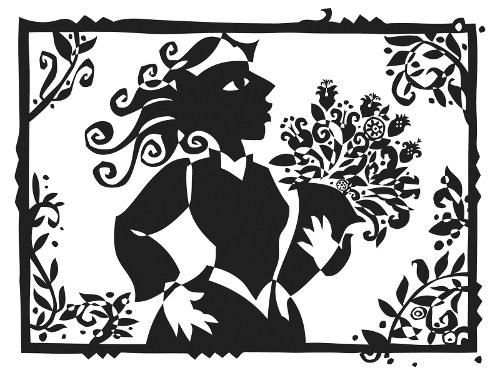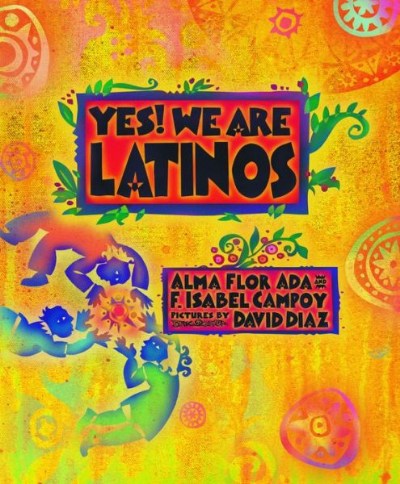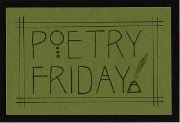
Which of the following statements is true?
- Hispanics/Latinos are a single race who all look alike
- All Latinos in the United States are recent immigrants, most of whom are here illegally
- All Latinos speak Spanish and sound alike
- Hispanic immigrants aren’t interested in learning English
- Latinos are the largest and fastest growing minority group in the country and have lived in the territories now known as the United States for over four centuries.
If you guessed the last one, you’re correct, but did any of the other statements sound familiar? Chances are good you’ve encountered people who actually believe they’re true.
That’s one of the reasons Yes! We Are Latinos by eminent authors and scholars Alma Flor Ada and F. Isabel Campoy (Charlesbridge, 2013), is a must read not only for young people but for everyone.

This wonderful celebration of the rich diversity and mixed cultural origins of the more than 50 million Latinos in the U.S. informs, enlightens, and helps to dispel many commonly-held misconceptions about who Latinos are and the nature of their vital, historic role in the fabric of our society.
In the book, we are treated to twelve free verse narrative poems told in the voices of thirteen fictional Hispanic children, each representing a different facet of the dynamic, ever-evolving Latino identity.
My name is Juanita. I am Mexican. I live in New York. I am Latina.
My name is Mónica. I am from El Salvador. I live in Houston. I am Latina.
My name is José Miguel — not Joe, not Mike. I am Cuban and Nicaraguan. I live in Tampa, Florida. I am Latino.
My name is Felipe. I am Panamanian and Venezuelan. I am black. I live in Chicago. I am Latino.
My name is Lili. I am Guatemalan. I am Chinese. I live in Los Angeles. I am Latina.
My name is Michiko. I am Japanese, a sansei. I live in Los Angeles. I am Latina.
You quickly get a sense of how broad a spectrum Latino culture encompasses. As the authors note, most Latinos are mestizos; “their heritage includes roots from indigenous, African, and Spanish people, as well as the many others who have settled in Latin America over centuries.”
It is fascinating to hear these unique stories and your heart can’t help but go out to the children as they talk about their hopes, challenges and struggles. Despite their beautiful differences, they are united by common threads:
- an enduring love and respect for family
- high value on education
- a desire to honor cultural history and heritage while embracing what it means to be American
- being bilingual or trilingual
- a fierce determination to realize their dreams for the future

It was especially interesting to hear from two Asian-Hispanics. I knew nothing about the history of Asians in Latin America, a subject that’s rarely covered in children’s literature.
Lili and Michiko only speak a little Chinese and Japanese. Like the people Lili mentions in their poem, if I met them I would be surprised to hear them speaking Spanish as their first language.
This is a great way of showing that Latinos/Latinas definitely do not all look alike or sound alike, nor do they fit into any kind of pre-conceived profile. I also liked learning about the other children whose first language is Mixtec, Zapotec, or Ladino instead of Spanish, and being reminded of the many creative and enterprising Hispanic individuals who’ve inspired us with their literary and visual art, or who have contributed to the economic success of this country.
Each of the poems is paired with a short informational essay providing historical and social context, broadening themes such as indigenous roots, immigration, assimilation, U.S.-Cuban relations, Spanish-American War, Spanish Civil War, the life of migrant farmworkers, and biodiversity.
But the heart of this book lies in the poems themselves — appreciating the finely sculpted, sensitively honed portraits and being touched by the characters’ personal yearnings for self actualization. When recently asked by Julie Danielson at Kirkus why they chose poetry to illuminate the Latino American experience, Campoy said:
Poetry is the chisel of language. It carves meaning until beauty appears, dancing with the rhythm of form . . . Poetry is also very possessive of meaning. It values simplicity in eloquence.
Now, meet this young Puerto Rican Latina whose fondest wish is for something other than a fancy coming-of-age party when she turns 15.

MY NAME IS
GLADYS
I am Puerto Rican.
I live in Philadelphia.
I am Latina.
My mother is so busy with my sister’s quinces.
She keeps calling on me to help.
“Gladys, ven hijita, por favor.”
Yolanda’s quinceañera party
is all we have been talking about
in my family
for the longest time.
It’s all about
the dress,
the tiara,
the cake,
the music,
the court of fourteen boys and girls
that will accompany her
in her rite of passage,
when all of a sudden
everyone will agree
she is no longer a girl
but a full-grown woman.
I love parties
with good music —
dancing lets me feel so free —
and there’s no question
Yolanda will be lovely
in her full, long dress.
“Just like a princess,”
they all said when she tried it on.
Mom, Abuelita, las tías y las primas,
everyone was repeating,
“Como una princesa.”
I will not say anything
until the party is over.
I plan to dance
all night long.
But when Mami
begins to talk
about mis quinces —
and I’m sure
she will begin soon —
I’ll tell her
the family does not need
to go broke again.
I love to dance,
but I don’t need
an elaborate party —
a quinceañera production —
to know I’m becoming a woman.
I just don’t believe it happens
in one day —
and what I want is something else.
I want Dad to stop saying
that it’s not a good idea
to go to college.
“Why all that study, m’hijita?
Why go through all that?
You need to learn to be a good wife,
hijita, a good mother, and that’s that.”
I don’t know if I will be a wife.
That requires finding someone, someday.
And if I become a mother,
I would try to be
as good as mine.
But before that
I need to become all I can be.
I want to go to college
and study.
I know it costs a lot,
and I’m not asking for the money.
I only ask that you not discourage me,
not make things any harder for me.
I will apply for work-study, loans, and scholarships,
like the counselor explained.
She insisted that
I must get very good grades
in junior high, so I will be well prepared for high school.
Encouragement to go on,
to succeed, to do better than my parents,
as they did better than theirs.
Going to college is my dream.
I want my parents
to encourage me.
That’s the quinces gift
that I want.

* * *
Caldecott Medalist David Diaz’s intricate folkoric hand-cut illustrations nicely complement these heartwarming vignettes, accentuating primary themes in the essays with their striking figures.
Both Latino and non-Latino readers will find much to ponder and enjoy in Yes! We Are Latinos, a much-needed, well researched, eye and mind-opening introduction to this colorful, distinctive, vibrant community.
In the final poem, Román, a Hispanic, Hispano, Español, Native American from New Mexico, says:
I realize the strength of my heritage,
the contradictions of our history,
the battles won and lost
within our hearts.
We have been mixing for centuries.
Mixing our blood, our faiths.
Mixing traditions, music, and dance.
Mixing our languages, our literatures.
Mixing us into a greater reality,
a larger identity.
One that is now called Latino.
Yes! We are Latinos.
* * *

YES! WE ARE LATINOS
written by Alma Flor Ada and F. Isabel Campoy
illustrated by David Diaz
published by Charlesbridge, 2013
Poetry and Nonfiction for ages 10-13, 96 pp.
*Includes Bibliography for Teachers and Parents and Additional Resources for Young People
**A Junior Library Guild Selection
* * *
 The lovely and talented Diane Mayr is hosting today’s Roundup at Random Noodling. Zip over and enjoy all the tasty poetic offerings being shared in the blogosphere this week.
The lovely and talented Diane Mayr is hosting today’s Roundup at Random Noodling. Zip over and enjoy all the tasty poetic offerings being shared in the blogosphere this week.
——————————
*Interior spreads from Yes! We Are Latinos posted by permission of the publisher, text copyright © 2013 Alma Flor Ada and F. Isabel Campoy, illustrations © 2013 David Diaz, published by Charlesbridge. All rights reserved.
Copyright © 2013 Jama Rattigan of Jama’s Alphabet Soup. All rights reserved.

This looks like a wonderful and important book!
LikeLike
I learned so much from reading it, Iza. 🙂
LikeLike
This is definitely a book I’ll have to look for. And, I love, love, love the quote by Campoy, “Poetry is the chisel of language.”
LikeLike
This one belongs in every school and public library!
LikeLike
I’m putting this on my library list. It looks beautiful and helpful. Thanks, Jama.
LikeLike
Yay! Thanks for stopping by to read :).
LikeLike
In Colorado and New Mexico, we try hard to keep the special designations true to the heritage, and, knowing our history helps. This looks like a great book for our library, Jama. I love the voice of these two young people, hopes and dreams! And the art, amazing to think someone can ‘cut’ the picture! Thank you!
LikeLike
Yes — it’s perfect for school libraries!
The illustrations are hand cut from Rubylith. 🙂
LikeLike
looking forward to reading this beautiful book and learning more..
.in the end, we’re all “mestizos” aren’t we?
LikeLike
Yes we are, Sharon :). Enjoy the book!
LikeLike
Wow – what an important book, Jama. Strong voices here which must be heard – thanks so much for sharing this today.
LikeLike
Definitely an important book — lots to digest.
LikeLike
This book sounds really interesting. I’m adding it to my list.
LikeLike
Glad to hear that! Yay!
LikeLike
Ah, I’m late today, but this book looks both fascinating and gorgeous. I’m going to come back and savor it. Thanks for sharing it.
LikeLike
Thanks for dropping by :).
LikeLike
I would definitely learn something from this wonderful book 😀
Cheers
Choc Chip Uru
LikeLike
Hello Uru!
LikeLike
I love how honest and personal Gladys’ poem is… based on that alone, I’d have to agree this book is a must-read. The hand-cut illustrations are not what I would have expected, but they are painstakingly gorgeous.
LikeLike
I like the stylized symbolism in the images. I learned something new in every poem and essay. Quite a feast of information :).
LikeLike
Wonderful book! It is very inspiring. 🙂
LikeLike
Yes, inspiring and informative!
LikeLike
Thank you so much for sharing this! It looks fabulous. I will definitely get my hands on one.
LikeLike
You will enjoy it!
LikeLike
Wow. You just want to give these young authors all the encouragement you can, don’t you? Kudos to the talented compilers and the contributing poets. And David Diaz, well – his work is magnificent all around. Thanks for sharing, Jama!
LikeLike
Kudos to Alma Flor Ada and F. Isabel Campoy for creating such convincing characters! They have said that these thirteen voices are conglomerates of people they have known or encountered. I agree with you on the magnificence of David Diaz’s work. 🙂
LikeLike
Inspiring post, Jama. It sounds like a fascinating and empowering book that kids of all backgrounds (and maybe some adults too) would do well to read!
LikeLike
Exactly right, Violet. Empowering is a great way to describe it. 🙂
LikeLike
Great find, Jama!
LikeLike
Thanks, Catherine. It’s important to bust stereotypes and clear up misconceptions about any minority group.
LikeLike
Exactly.
LikeLike
I just came across Alma Flor Ada’s autobiography, Under the Royal Palms, and now you highlight this beautiful book. It’s a sign! Thanks for sharing!
LikeLike
It’s definitely a sign — meaning I have to read Under the Royal Palms next! 🙂
LikeLike
Thanks for sharing. Alma Flor Ada is a force for good in the world!
LikeLike
Have to agree!
LikeLike